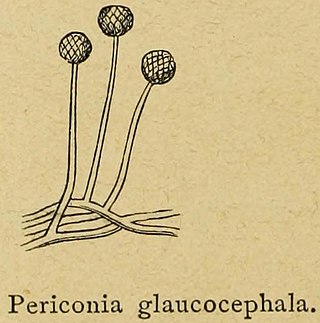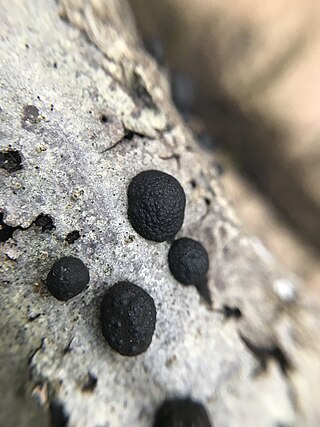
The geology of Great Britain is renowned for its diversity. As a result of its eventful geological history, Great Britain shows a rich variety of landscapes across the constituent countries of England, Wales and Scotland. Rocks of almost all geological ages are represented at outcrop, from the Archaean onwards.

The Boletaceae are a family of mushroom-forming fungi, primarily characterised by small pores on the spore-bearing hymenial surface, instead of gills as are found in most agarics. Nearly as widely distributed as the agarics, the family is renowned for hosting some prime edible species highly sought after by mushroom hunters worldwide, such as the cep or king bolete . A number of rare or threatened species are also present in the family, that have become the focus of increasing conservation concerns. As a whole, the typical members of the family are commonly known as boletes.

The Agaricaceae are a family of basidiomycete fungi and include the genus Agaricus, as well as basidiomycetes previously classified in the families Tulostomataceae, Lepiotaceae, and Lycoperdaceae.

The sporocarp of fungi is a multicellular structure on which spore-producing structures, such as basidia or asci, are borne. The fruitbody is part of the sexual phase of a fungal life cycle, while the rest of the life cycle is characterized by vegetative mycelial growth and asexual spore production.

Rosellinia is a genus of fungi in the family Xylariaceae consisting of over 90 species. Several of the species in this genus are plant pathogens. Fossils of Rosellinia have been found in 12 million year old rocks from central England.
Acrogenospora is a genus of fungi in the family Hysteriaceae. Fossil Acrogenospora have been reported from 12 million year old rocks from central England.

Annulohypoxylon, sometimes called cramp balls, is a genus of fungi in the family Xylariaceae. The 27 species in the genus have a collectively widespread distribution.
Helicogermslita is a genus of fungi in the family Xylariaceae. Fossils have been found in rocks 12 million year old sediments from central England.

Kretzschmaria is a genus of fungi in the family Xylariaceae. The genus, circumscribed by Swedish mycologist Elias Magnus Fries in 1849, contains about 30 species that collectively have a widespread distribution. Fossils of Kretzschmaria have been found in the 12 million year old rocks from central England.

Equinae is a subfamily of the family Equidae, known from the Hemingfordian stage of the Early Miocene onwards. They originated in North America, before dispersing to every continent except Australia and Antarctica. They are thought to be a monophyletic grouping. Members of the subfamily are referred to as equines; the only extant equines are the horses, asses, and zebras of the genus Equus, with two other genera Haringtonhippus and Hippidion becoming extinct at the beginning of the Holocene, around 11-12,000 years ago.

Leucoagaricus is a genus of mushroom-forming fungi in the family Agaricaceae. As of March 2023 there are over 200 accepted species of Leucoagaricus with ongoing research into the genus adding several more each year. Leucocoprinus is a similar genus and considered by some sources to be indistinct from Leucoagaricus based on genetic data that demonstrates they are monophyletic. Species are separated into these genera based on macroscopic features such as cap striations in Leucocoprinus or the more persistent basidiocarps (mushrooms) of Leucoagaricus as well as microscopic features such as the lack of a germ pore in Leucoagaricus species. As a result of the similarities and disagreement on taxonomy, many of the species within these genera have formerly been classified in the other and may still be known by previous classifications. For instance the species Leucoagaricus gongylophorus is cultivated by fungus-growing ants but was formerly known as Leucocoprinus gongylophorus whilst other species cultivated by the lesser attine ants are still classified as undescribed Leucocoprinus species.

Podospora is a genus of fungi in the family Podosporaceae. Fossils of Podospora have been reported from 12 million year old rocks from central England.

The Chaetosphaeriaceae are a family of fungi in the Ascomycota, class Sordariomycetes. The family was circumscribed by Martina Réblová, Margaret Elizabeth Barr Bigelow, and Gary Samuels in 1999. Species in the family have a cosmopolitan distribution, and are found in both temperate and tropical climates. Fossils of the Chaetosphaeriaceae are known from the Carboniferous, Eocene, Oligocene, Miocene and more recent sediments.

Periconia is a genus of sac fungi in the order Pleosporales. Fossils of Periconia have been reported from 12 million year old rocks from central England.
The Brassington Formation is a geological formation in the United Kingdom, and the country's most significant onshore Miocene deposit. it is preserved as around 60 inliers in karsts of Carboniferous limestone, specifically the Peak Limestone Group, in a triangular region on the borders of the Staffordshire and Derbyshire counties. The lithology largely consists of unconsolidated sand with clay and minor silt components. Pebble beds are also a significant component. It is divided up into three members, which are in ascending order the Kirkham Member, Bees Nest Member and the Kenslow Member. The Kenslow Member is dated to the Serravallian to Tortonian stages based on palynology.
Nigrospora is a genus of fungi in the family Trichosphaeriaceae.

Hyainailourinae ("hyena-cats") is an extinct subfamily of hyainailourid hyaenodonts that lived in Africa, Asia, North America and Europe from the middle Eocene to middle Miocene. They appeared in Africa about 47.8 Ma ago and soon after spread as far as East Asia.

Annulohypoxylon annulatum is a pyrenomycete, a carbonaceous fungus that produces its ascospores in perithecia, and then shoots them out through an opening called the ostiole. Annulohypoxylon was derived from the original genus Hypoxylon in 2005 and is distinguished by their flat, disk-like rings encircling the ostioles. The stromata of A. annulatum are semi-globose to cushion-like and are black in color. They are covered in ostioles surrounded by a flat disc area. A hand lens may be needed in order to see this. This species commonly grows on oak and when crushed and mixed with potassium hydroxide will produce an olive green pigment. Microscopically, "ascospores brown to dark brown, ellipsoid-inequilateral, 7.5-12 × 3.5-5 µm, with straight germ slit spore-length".













